How To Deadlift: Your Expert Form Guide To The King Of Lifts
Improve your deadlift form with our expert how to guide, tips from a world record holder, variations and more
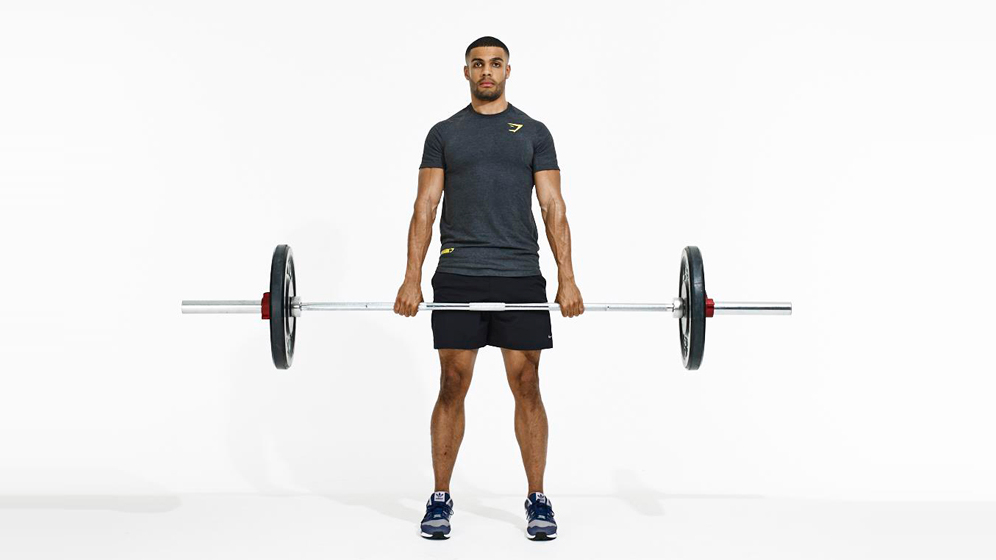
Weightlifting in its purest form is lifting something up and putting it back down. That’s the deadlift in a nutshell. It’s simplicity personified and one of the best muscle-growing, strength-building, health-improving moves around. It’s an essential component of any good strength training plan, along with the barbell squat and the bench press.
Of course, that all depends on knowing how to deadlift safely, so to help you understand the correct form and the ins and outs of the move, we’ve spoken to numerous experts to share this comprehensive guide. Follow our tips and aim for the holy grail of a double bodyweight deadlift, as we explain how to do this classic move.
The Benefits Of The Deadlift
The deadlift is one of the best total-body moves for building strength and power, because it allows you to shift more weight than its powerlifting counterparts the back squat and bench press.
Wahoo Sports Science’s expert strength coach Jeff Hoobler firmly believes it’s a beneficial tool to have in your strength-boosting exercise arsenal. “It’s a multi-joint exercise, so you’re getting distribution of load throughout the body – but it needs to be done properly,” he says.
The deadlift works the quads, hamstrings and glutes, as well as the rest of your posterior chain – the muscles that run along the rear of your body from neck to heels. And that’s not all.
“If done properly, you’re engaging the core,” says Hoobler. “And I want to be clear, the core is not just the six-pack. It’s everything from the shoulders to the hips, 360° around your body.”
This includes the transverse abdominis, erector spinae, and internal and external obliques. In fact, studies have shown that the erector spinae is more engaged during deadlift exercises than the glutes and the biceps femoris, one of the hamstrings muscles, according to a 2020 systematic review published in the journal PLoS One.
Get the Coach Newsletter
Sign up for workout ideas, training advice, reviews of the latest gear and more.
Strong core muscles are vital for powering rotational movements, as well as for stabilizing the spine and taking load off the lower back, preventing injuries in this area. Moreover, exercise programs that incorporate deadlifts may help reduce lower-back pain, but only in individuals who have enough hip and spinal mobility to perform this exercise safely, according to a 2021 review published in the Human Kinetics Journal.
Thanks to its compound nature, the deadlift is a great exercise to improve performance in a variety of sports. A strong core and a solid hip hinge (the ability to maintain a neutral spine while bending forward) are essential in activities that include running, jumping and powerlifting. Deadlifts are also great at developing balance and stability, which can boost performance in combat sports and martial arts.
Deadlifts may also improve knee function in novice lifters, according to a 2015 study published in the Journal Of Strength And Conditioning Research. Researchers recruited 54 previously untrained individuals, divided them into two groups, and instructed one group to perform deadlifts twice a week for 10 weeks. Participants in the second group did not take part in any structured exercise program during that time. Following the experiment, individuals in the training group could jump on average 7.4% higher than the ones in the control group. Deadlifts also appeared to significantly improve the strength of the muscles surrounding their knee joints.
Deadlift Risks
Heavy deadlifts are responsible for a significant number of lower back and hamstring injuries among athletes. When not done properly, this movement can lead to stress fractures, muscle ruptures and ligament tears, according to a 2018 review published in the journal BMJ Open Sport & Exercise Medicine. Therefore, deadlifts may not be suitable for individuals with poor posture and reduced mobility, or those who struggle with co-ordination and body awareness. This exercise is also a no-go for anyone with existing lower back injuries, the review authors noted.
In addition, heavy deadlifts require an appropriate set-up of an Olympic barbell, bumper weight plates and a weightlifting platform. Not only does the use of this equipment minimize the risks of damaging the floor, but the taller bumper plates result in a better starting position that encourages you to use your legs, rather than your back, to initiate the movement.
How To Deadlift
The deadlift is one of the best total-body moves for building muscle and burning fat, but only if you do it right. Use strength coach Andy McKenzie’s deadlift form advice to nail the lift.
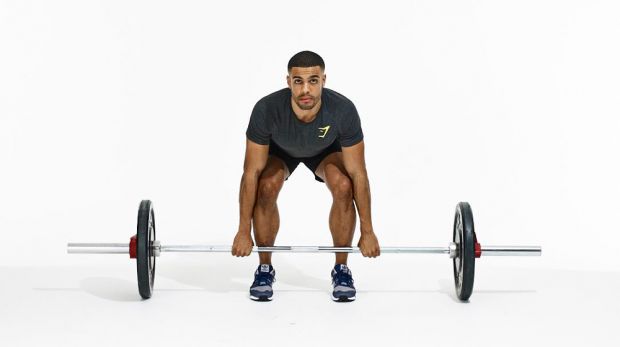
To start, here’s an overview of the basic movement. “Standing with your feet shoulder-width apart, grasp the bar with your hands just outside your legs,” says McKenzie. “Lift the bar by driving your hips forwards, keeping a flat back. Lower the bar under control—though once you get up to really heavy weights, it’s okay to drop it on your final rep.”

Of course, there’s much more to consider if you want perfect deadlift form (and believe us when you say you do). Here are some of the finer points to master.
“Place your thumbs against the outer part of your thigh, and run both hands down until they touch the bar,” says McKenzie. “This is your ideal hand position.
“As for your grip, you have two choices: a double overhand grip or a mixed grip, where one hand grips the bar overhand and the other underhand. The mixed grip will allow you to lift heavier, but make sure you switch hands regularly to prevent developing any muscular imbalances.
“Always ensure you squeeze the bar as hard as you can, especially in heavier sets, before the bar leaves the floor.
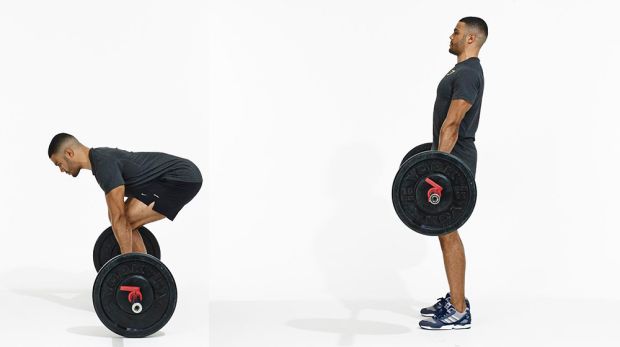
“Keep your head in a neutral position throughout the lift. This is achieved by looking forwards with your eyes fixed to a spot on the ground about two to three meters ahead of your feet. And focus on keeping your chin up to keep your head in the best position for lifting.
“You want to maintain a strong spine from the beginning of the lift to the end, and the best way to achieve this is to keep your chest up throughout to prevent your torso hunching forwards over the bar.
“You need to keep your abs braced throughout the entire move to maintain an arched lower back and a strong and stable body, especially when attempting heavier lifts. Engage your core from the very start so your abs are tensed as you squat down to grip the bar. As you are about to lift the bar, breathe deep into your belly, hold your breath, and brace your abs hard, like you’re about to be punched in the stomach.
“Your shoulders should remain slightly in front of your hands until the bar passes mid-thigh level, at which point you want to retract your shoulder blades for a strong and stable torso.”
Deadlift Form Tips
To round out McKenzie’s form guide, we’ve included more pointers from Hoobler and former world deadlift record holder Andy Bolton, plus four more for good measure.
Set up for success
“Approach the barbell and stand with your feet shoulder-width apart so your shins are touching it,” says Hoobler. “Squat down, making sure your hips are lower than your chest.
“Then grab the bar with a double overhand grip and brace; to do this, take a big inhale, let out a partial exhale, then brace [or squeeze] your midsection. The most important thing is the brace, and that people keep their spine neutral.”
As you progress and add more plates to the bar, you may want to try a mixed grip, where one hand takes an overhand grip and the other grips underhand.
This will allow you to lift heavier weights without your grip strength becoming the limiting factor, but you should switch the role of your hands regularly to prevent any muscle imbalances forming.
Lift in harmony
“Take the tension of the bar,” says Bolton. “You need to pull it hard and fast but never snatch it or you’ll risk injury. Looking straight ahead, exhale, then take a deep breath and drive your heels into the floor, and push up using the muscles of both your lower back and legs so that the bar reaches your knees.”
Drive and lock
“Ensure that your legs lock and your back straightens at the same time,” says Bolton. “Once you’re straight, retract your shoulder blades and hold your head high, keeping the bar under full control. Then reverse every part of the move to lower the bar back to the ground.”
Go shoeless
Most lower-body moves will benefit from weightlifting shoes, but in deadlifts they’re counter-productive—not only will they give you more height to lift, but they’ll tilt you slightly forward, throwing your movement pattern off. For best results, lift in flat shoes—think Converse—or in socks or barefoot. It’ll give you a stable platform to lift from.
Scrape your shins
The further the bar strays from your body, the harder to lift it will be—there’s a reason world champ Eddie Hall ends every record attempt with bleeding shins. Start your lift with your toes under the bar and your shins against it, then pull straight up. You might want to invest in a long pair of socks.
Belt up
You can instantly add around 12kg to your deadlift simply by wearing a weight lifting belt. Breathing into your stomach and pushing against the belt with your abdominal muscles will increase intra-abdominal pressure, creating a more stable core, a necessity when lifting heavier weights.
Get a grip
It won’t matter how much you strengthen your back and your legs, you won’t be able to deadlift heavy weights if your hands can’t hold the barbell. To develop a strong grip, try using chalk and practice white knuckling (gripping any bar that you encounter as hard as you can) to tighten that grasp.
Common Mistakes
Scott Britton, CrossFit and powerlifting athlete as well as the co-founder of charitable fitness competition Battle Cancer, highlights the mistakes he often sees people make when attempting to deadlift.
Rounding the back
“Every time I see a rounded back I see herniated discs, long physio sessions and pain,” says Britton. “Spending time concentrating on keeping your back straight when lifting will save you years in the therapy room. Imagine someone has put a broom across your back and, when bending over to lift, your back has to stay as straight as that broom.”
Incorrect breathing
“Learning the right breathing pattern for the exercise can take a long time,” says Britton. “but when deadlifting it’s essential to hold a big breath before you try to lift off the ground, and then let that breath out only when you have the lift completed.”
Dropping the bar after you lift it
“If you can pick it up, you can put it down,“ says Britton. “A lot of injuries occur when people drop the barbell from the waist. You have put your leg, back and stomach muscles under serious stress then let it go suddenly. Your muscles can act like a coiled spring and snap! Hold on and put the bar back down. What I do is imagine glass is under the bar so I pop it down nice and gently.”
Deadlift Variations
Romanian deadlift
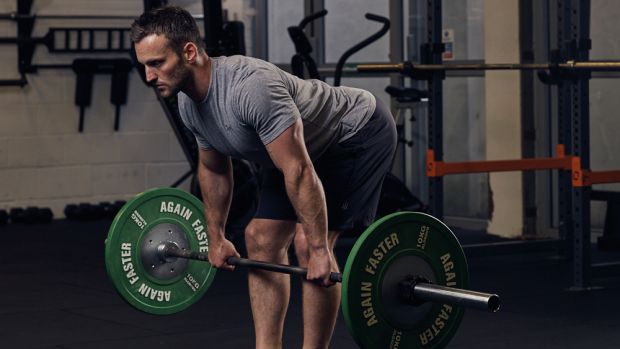
This variation shifts the emphasis to your hamstrings, building flexibility as well as strength, power and control in these often neglected leg muscles. Stand tall with your feet shoulder-width apart, holding a barbell off the floor with an overhand grip just outside your thighs. Keeping a slight bend in your knees, bend forward from the hips—not the waist—and lower the bar down the front of your shins until you feel a good stretch in your hamstrings. There’s no need to go heavy for the Romanian deadlift to be effective, so start small.
Snatch-grip deadlift
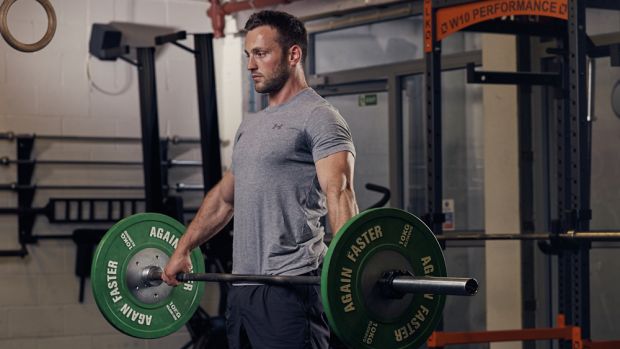
The wider grip employed here places greater emphasis on your upper back (trapezius) muscles. You’ll also need to move the bar through a greater range of motion. Hold a barbell (check out our guide to the best barbells you can buy) with your hands approximately double shoulder-width apart. Push through your heels and keep your chest up as you drive forward with your hips to lift the bar.
Trap bar deadlift
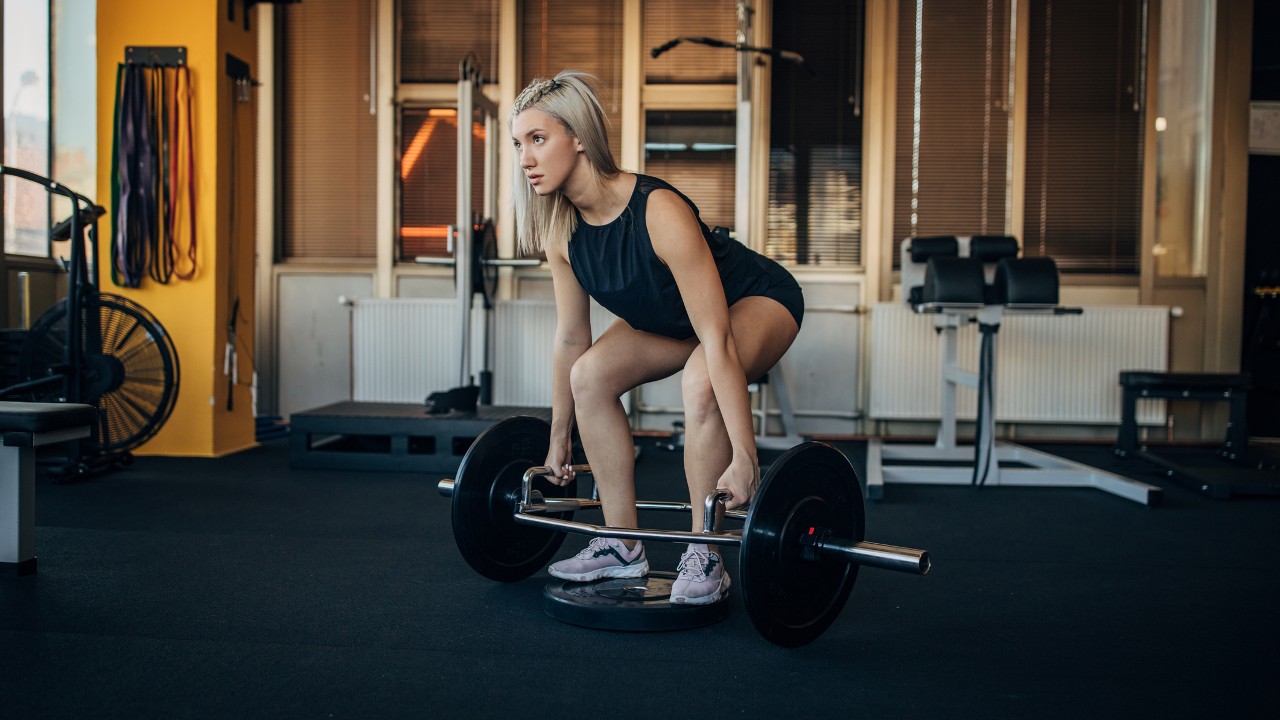
You may also find this version referred to as the hex bar deadlift, owing to the hexagonal shape of the bar that’s used. This is a brilliantly effective version of the deadlift, with the side-on position of the trap bar handles forcing you to retract your shoulder blades and engage your lats. It’s great for making swift strength gains and doesn’t put as much pressure on your lower back as other deadlift variants because you won’t be pulled forward.
Deficit deadlift
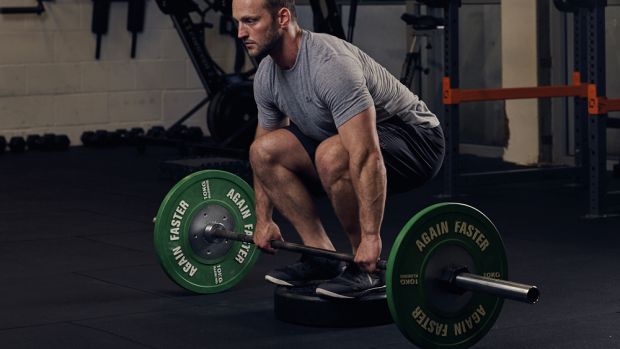
Lifting from a “deficit”—an artificially lower start position—will fix any weakness in your deadlift form, forcing you to keep your back flat and shoulders engaged to get the bar off the ground. Stand on a weight plate or low box and grasp the bar. Engage your shoulders and take the strain, then lift the bar by driving your hips forward, keeping a flat back.
Sumo deadlift
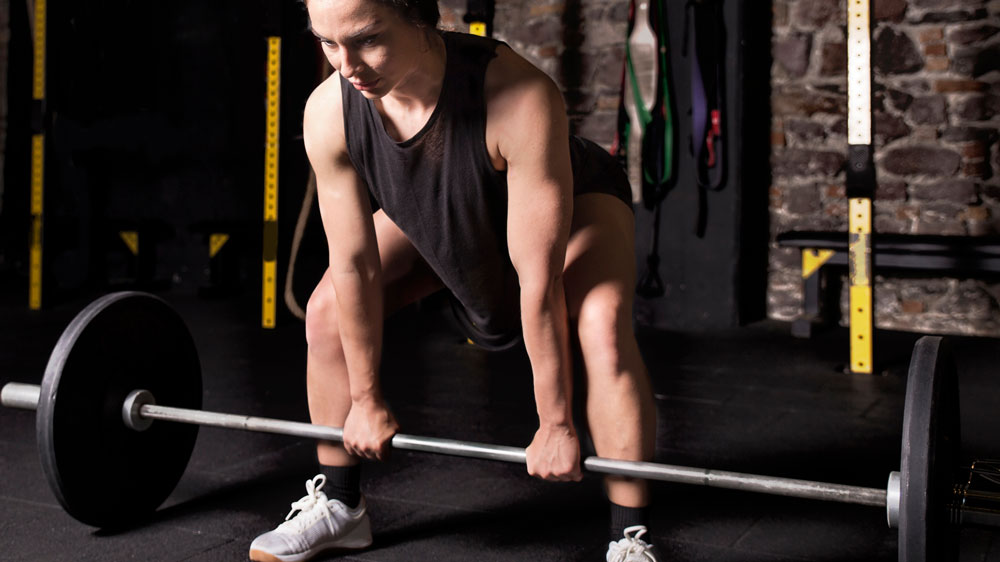
This variation targets the muscles in your hamstrings, making it a great builder for leg power, and as with the Romanian deadlift it’s wise to use a significantly lighter weight. Place your feet wider apart and grasp the bar with a slightly narrower grip than you would with a regular deadlift.
Rack pull
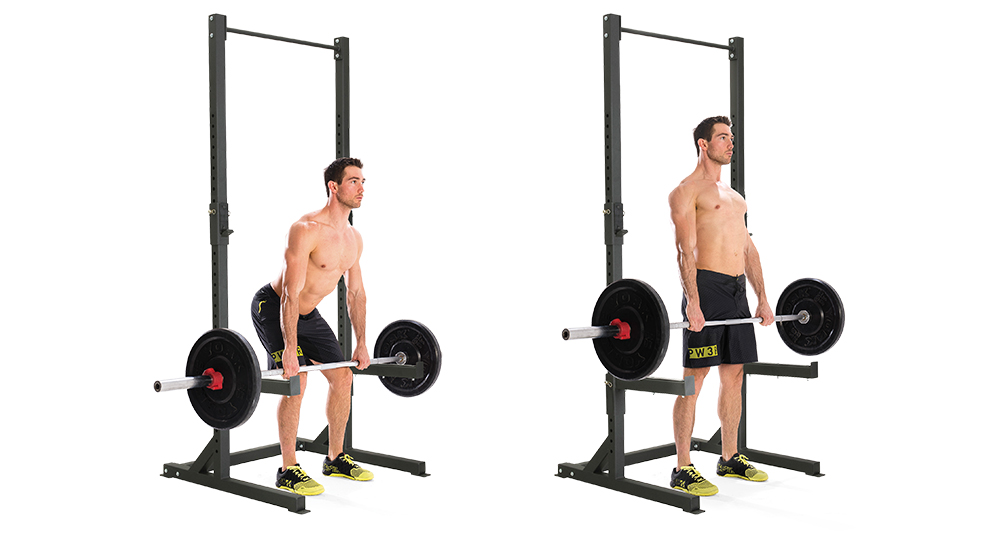
If you find the range of motion of normal deadlifts too strenuous, start with the barbell raised on blocks or a rack. This is a good variation to start with until you are more confident with the movement required because it places less strain on your lower back.
Single-leg Romanian deadlift
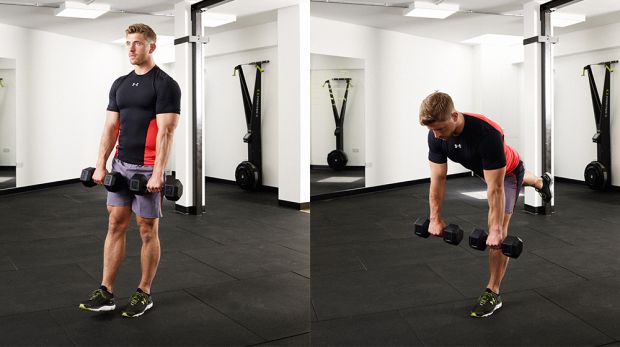
This unilateral move develops balance, ankle stability and your hamstrings, but it can be very tricky, especially for your first few attempts, so master the bodyweight version first before adding free weights. Stand on one leg, then hinge forwards at your hips, sending your elevated leg backwards to help maintain your balance and reaching towards your toes until you feel a stretch in your hamstring. Reverse the move to the start.
Deadlift Challenges
Try these advanced but rewarding deadlift challenges to get bigger, leaner and stronger than ever.
Get strong with a 1RM test
What Your 1RM (one-rep max) is the amount of weight you can lift for one rep. After a thorough warm-up, do two or three reps at about 50% of your maximum lift. Add 10-20kg to the bar and repeat until you get to around 85% of your maximum. Then add 5kg and do one rep until you fail. Your last successful lift is your 1RM.
Why The most effective way to get stronger is to focus on performing low-rep sets.
Get lean with deadlift EMOMs
What EMOM stands for Every Minute On The Minute. Get a weight you can lift for 15 reps (this will be approximately 65% of the weight you could lift once), start a clock and do as many reps as you can in 30 seconds. Rest for 30 seconds and then repeat on the minute, every minute, for 10 minutes.
Why You complete a huge amount of work in a short space of time, which will get your heart pumping.
Get big with deadlift GVT
What German Volume Training was popularised by strength coach Charles Poliquin. In this workout, you use a weight that’s approximately 60% of what you could lift for one rep. Do 10 reps, rest for 90 seconds and repeat that 10 times. If you fail before the end of a set, do as many reps as you can.
Why Maximising volume—the total amount of weight you lift—is one of the keys to muscle growth.
Deadlift FAQs
To answer some of the most common questions about deadlifts, we enlisted personal trainer Emily Servante, global trainer education manager at Ultimate Performance.
What is deadlifting good for?
“The deadlift is one of the best compound moves you can perform in the gym if you want to develop a lot of muscle mass and build strength,” says Servante. “A compound move is an exercise that hits several different muscle groups all at once and because deadlifting is conducive to using heavy loads, it is an exercise that will give a lot of bang for your buck.
“Given the sheer amount of energy needed to perform the deadlift correctly, the number of muscle groups the move recruits, and the ability to go heavy with this exercise (if you can do it safely), the consequence is putting on serious muscle. This in turn will raise your metabolic rate and burn fat. Muscle is actively metabolic tissue which means it is always in an active state of burning energy. The more muscle mass you have, the more energy you burn, and the higher your metabolism will be.
“Because the deadlift is a functional, multi-joint move that targets every muscle in your body, it can benefit your day-to-day life in ways you probably don’t expect. From improving your posture to carrying groceries, playing with your children or doing household chores – you’ll be amazed how improving your deadlift form and strength carries over into all kinds of daily activities.”
Are deadlifts bad for you?
No, the deadlift isn’t bad for you, as long as you perform it correctly.
“Whether I was discussing performing a deadlift, squat or doing yoga, I would answer this question the same way,” says Hoobler. “If you do it properly, it’s totally fine.” However, “there needs to be an awareness that, if it doesn’t feel right, you should regress and build back up.”
“The deadlift, as familiar as it is, is not what I would start a newcomer with,” says Hoobler. “First, what I’d do is find out if someone can brace through their midsection, and if they can hinge at the hip. I also want to find out what their effective range of motion is at the hips without losing the integrity of their spine—keeping a neutral spine is key.”
If people can demonstrate they are capable in all three of these areas, Hoobler says he would start them off with a Romanian deadlift, starting with the bar in a rack rather than picking it up off the floor.
“The reason I do that is it’s easier to teach people to brace their midsection in a standing position, and it’s also easier to unlock the hips [push them backward to initiate the movement] and make sure you maintain the integrity of the spine.”
Do deadlifts build muscle? What muscles do they work?
“Primarily, deadlifts work your back and your entire posterior chain,” says Servante. “The posterior chain is what gives our bodies a strong foundation and its ability to generate power, and refers to the back side of your body – specifically your calves, hamstrings, glutes and erector spinae [the muscles around your spine]. Deadlifts also work your quadriceps, back, trapezius, rear deltoids and forearms. You’ll struggle to find a better exercise that works so many muscle groups at the same time.”
What is a good deadlift weight?
“It depends!” says Servante. “What constitutes a good deadlift weight for one person might be either very light or far too heavy for someone else.
“The more weight you can lift with good form, the stronger you’re going to get, and the deadlift is one move where you should probably try to go as heavy as you can without compromising form. However, the heavier the weight, the higher the risk-to-reward ratio. Very heavy loading comes with a higher risk of injury and requires more rest between sets for the nervous system to recover.
“At Ultimate Performance, our goal is to train clients to the point where they cannot complete another rep with good technique. Put simply, it means your muscles simply cannot move the weight. That is known as mechanical or muscular failure. In contrast, technical failure is where your form breaks down, but you could probably still crank out a rep or two.
“Regardless of your experience with the deadlift, a good weight is a weight you can lift for, say, three sets of eight reps, with perfect form, until your muscles simply cannot take any more. If your technique is breaking down on the seventh or eighth rep, and you are compromising form to hit those last one or two reps, you’re probably going too heavy.
“For more experienced lifters, you might have heard the phrase one-rep maximum. That is the absolute maximum amount of weight you can lift to perform one rep of any given exercise.
“Say your one-rep maximum deadlift weight is 140kg. You know you can’t perform 10 reps at this weight, so if you struggle on and try to perform multiple reps at close to your one-rep maximum, you’re going to have poor form and poor technique, and put yourself at serious risk of injury.
“Instead, keep in mind that every lift above 70% of your one-rep max will increase strength. So if you can deadlift 140kg for one rep, performing reps with 98kg and above will still build strength.
“You will also find your deadlift form suffers when performing high reps, even with lighter weights. You’re better off performing low reps with the lighter weight, stopping well before any failure of technique.”
How much should a beginner deadlift?
Hoobler and Servante agree that numbers don’t matter, form does. “A good deadlift weight for a beginner is one that challenges your body to complete all the reps, and all the sets, while always maintaining perfect form,” says Servante.
“If you don’t have the movement pattern down, you shouldn’t deadlift, period,” says Hoobler. “I would start with 50% of their bodyweight, and make sure they can perform the move impeccably before increasing the weight. That’s pretty light, but it’s a weight they can control.”
More About Our Experts
Jeff Hoobler has more than 25 years’ experience as a cycling and strength coach. He is a certified strength and conditioning specialist through the US National Strength and Conditioning Association, and holds a degree in sports psychology and exercise science from the University of Kansas. He is also a USAC level 3 cycling coach, foundations training instructor and MAT (Muscle Activation Techniques) therapist.
Andy McKenzie is a UKSCA-accredited strength coach, and a strength and conditioning specialist. He is a former British army physical trainer, specialising in functional strength, sports-specific training, injury prevention and nutrition.
From 2008 to 2018, Joel worked for Men's Fitness, which predated, and then shared a website with, Coach. Though he spent years running the hills of Bath, he’s since ditched his trainers for a succession of Converse high-tops, since they’re better suited to his love of pulling vans, lifting cars, and hefting logs in a succession of strongman competitions.
- Harry BullmoreStaff writer
- Nick Harris-FrySenior writer
- Anna GoraHealth writer

